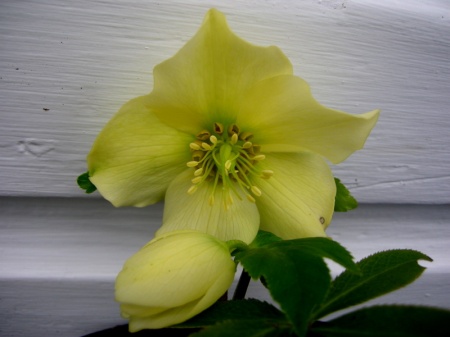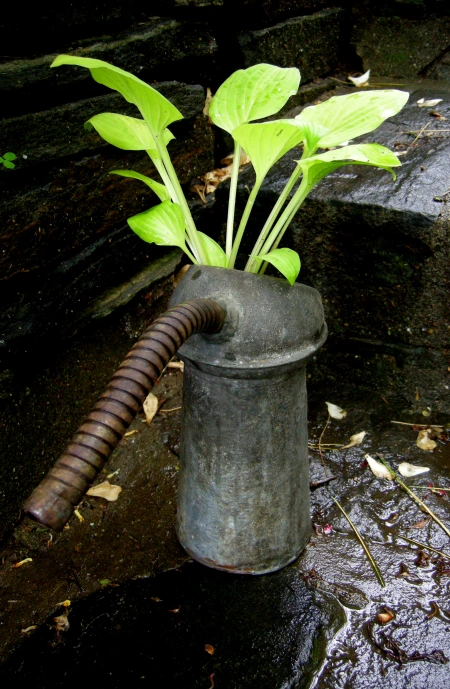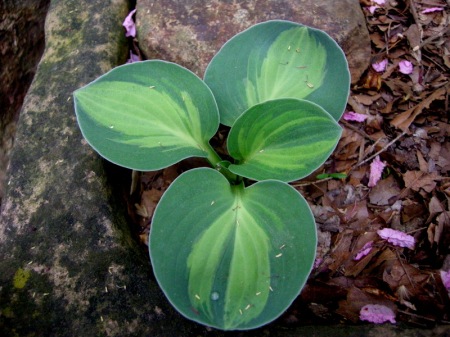Carolyn’s Shade Gardens is a retail nursery located in Bryn Mawr, PA, specializing in showy, colorful, and unusual plants for shade. The only plants that we ship are snowdrops and miniature hostas. For catalogues and announcements of events, please send your full name, location, and phone number (for back up use only) to carolyn@carolynsshadegardens.com. Click here to get to the home page of our website for catalogues and information about our nursery and to subscribe to our blog.
 This is just one of the many gorgeous hellebores that will be for sale at my nursery this spring. ‘Warber’ is a lovely creamy yellow and is blooming in a pot for me right now.
This is just one of the many gorgeous hellebores that will be for sale at my nursery this spring. ‘Warber’ is a lovely creamy yellow and is blooming in a pot for me right now.
It is the middle of the month and time to participate in Garden Blogger’s Bloom Day (GBBD) hosted by May Dreams Gardens (link available on February 15) where gardeners from all over the world publish photos each month of what’s blooming in their gardens. I participate because it is fun and educational for me to identify what plants make my gardens shine at different times of the year. Several nursery customers have mentioned wanting to have color in late winter so I hope they will get some ideas for plants to add to their own gardens to extend their season.
My garden is located in Bryn Mawr (outside Philadelphia), Pennsylvania, U.S., in zone 6B.
 ‘First Cuckoo’ is a double hellebore with white petals shading to pink with deep raspberry edges. It is also blooming in a pot and will be for sale this year.
‘First Cuckoo’ is a double hellebore with white petals shading to pink with deep raspberry edges. It is also blooming in a pot and will be for sale this year.
Things really change from year to year. In February 2011, my hellebores and other winter interest plants were barely emerging from under the ice and snow (to see photos click here). In February 2012 when we had an extremely warm winter, all my hellebores were in full bloom (to see photos click here).
This year, my early plants are up and blooming, but most of my hellebores are just starting to send up flowers. That makes me appreciate the early-blooming varieties even more. But it is the snowdrops that really steal the show right now. They give me a reason to walk through the garden every day. So enjoy the photos and keep warm until spring. Note: For the benefit of my customers, I will indicate which hellebores will be for sale at Carolyn’s Shade Gardens (CSG) this spring.
.
.
 ‘Pink Frost, pictured here with common snowdrops,’ is an early blooming hellebore coveted for its flowers and blue leaves with burgundy highlights. I can’t decide if the front or the back of the flowers is prettier (for sale at CSG).
‘Pink Frost, pictured here with common snowdrops,’ is an early blooming hellebore coveted for its flowers and blue leaves with burgundy highlights. I can’t decide if the front or the back of the flowers is prettier (for sale at CSG).
.
 ‘Cinnamon Snow’ is a close relative of ‘Pink Frost’—they both resulted from crosses between Christmas rose and a hellebore species from Majorca. ‘Cinnamon Snow’s’ creamy flowers flushed with cinnamon pink are very elegant (for sale at CSG).
‘Cinnamon Snow’ is a close relative of ‘Pink Frost’—they both resulted from crosses between Christmas rose and a hellebore species from Majorca. ‘Cinnamon Snow’s’ creamy flowers flushed with cinnamon pink are very elegant (for sale at CSG).
.
 This hellebore is so rare it has no common name but its botanical name is Helleborus dumetorum subsp. atrorubens (for sale at CSG).
This hellebore is so rare it has no common name but its botanical name is Helleborus dumetorum subsp. atrorubens (for sale at CSG).
.
.
 Christmas roses bloom continually in my garden from October through April. ‘Praecox’ is the showiest right now but I also love ‘Jacob’, ‘Josef Lemper’, and ‘Potter’s Wheel’ (for sale at CSG).
Christmas roses bloom continually in my garden from October through April. ‘Praecox’ is the showiest right now but I also love ‘Jacob’, ‘Josef Lemper’, and ‘Potter’s Wheel’ (for sale at CSG).
.
 ‘Old Early Purple’ is always one of the first hybrid hellebores to burst into bloom.
‘Old Early Purple’ is always one of the first hybrid hellebores to burst into bloom.
.
 This flower on ‘Snow White’ opened so long ago that it is already fading to green from its original pristine white color.
This flower on ‘Snow White’ opened so long ago that it is already fading to green from its original pristine white color.
.
.
.
 ‘Painted Bunting’ is always one of the first hybrid hellebores to bloom in my garden. The bold burgundy red central central star spreads outward along the veins and edges the delicate petals. Again the back of the flower is quite beautiful (for sale at CSG).
‘Painted Bunting’ is always one of the first hybrid hellebores to bloom in my garden. The bold burgundy red central central star spreads outward along the veins and edges the delicate petals. Again the back of the flower is quite beautiful (for sale at CSG).
I managed to limit myself to eight snowdrops, all of which I think are very special.
 ‘S. Arnott’, a classic early snowdrop.
‘S. Arnott’, a classic early snowdrop.
.
 The fat, rounded flowers and heart-shaped markings of ‘Ophelia’, a double snowdrop in the Greatorex group.
The fat, rounded flowers and heart-shaped markings of ‘Ophelia’, a double snowdrop in the Greatorex group.
.
 Even non-galanthophiles admire ‘Wendy’s Gold’, a rare yellow snowdrop.
Even non-galanthophiles admire ‘Wendy’s Gold’, a rare yellow snowdrop.
.
 I fell in love with the extra long petals of ‘Kite’ when I saw it in a fellow galanthophile’s garden in 2010, and she kindly gave me a plant. Now there are five with four flowers.
I fell in love with the extra long petals of ‘Kite’ when I saw it in a fellow galanthophile’s garden in 2010, and she kindly gave me a plant. Now there are five with four flowers.
.
 ‘Blewbury Tart’ is just waiting for a warm sunny day to explode into bloom. You can feel the pent up energy. Unfortunately sunny days are few and far between right now.
‘Blewbury Tart’ is just waiting for a warm sunny day to explode into bloom. You can feel the pent up energy. Unfortunately sunny days are few and far between right now.
.
 The refined elegance of the double snowdrop ‘Lady Beatrix Stanley’ makes her one of my favorites.
The refined elegance of the double snowdrop ‘Lady Beatrix Stanley’ makes her one of my favorites.
.
 I got this unnamed giant snowdrop, Galanthus elwesii, in trade from a customer. It has very large flowers with a distinctive X marking and starts blooming before Christmas, a very desirable trait. It is still blooming now.
I got this unnamed giant snowdrop, Galanthus elwesii, in trade from a customer. It has very large flowers with a distinctive X marking and starts blooming before Christmas, a very desirable trait. It is still blooming now.
.
 ‘Godfrey Owen’ is the snowdrop that I was most looking forward to this year. It is very unusual for having 6 outer segments instead of the usual three. When it opens, the petals form a completely symmetrical whorl. Unfortunately, the flower was flattened by ice immediately upon opening, bending the stem, and then an insect ate away parts of the petals, ruining the whorl. Isn’t that always the way? I tried to prop it up unsuccessfully but then bit the bullet and brought it inside.
‘Godfrey Owen’ is the snowdrop that I was most looking forward to this year. It is very unusual for having 6 outer segments instead of the usual three. When it opens, the petals form a completely symmetrical whorl. Unfortunately, the flower was flattened by ice immediately upon opening, bending the stem, and then an insect ate away parts of the petals, ruining the whorl. Isn’t that always the way? I tried to prop it up unsuccessfully but then bit the bullet and brought it inside.
There are many other plants blooming right now, but it has been so hard to get photos. The flowers are always closed because the sun refuses to shine, or waterlogged with the never ending rain and snow. In fact, three of these photos are from previous years, but I decided to use them because they depict the plants as they look today:
 Whenever the weather warms up winter jasmine, Jasminum nudiflorum, opens some flowers.
Whenever the weather warms up winter jasmine, Jasminum nudiflorum, opens some flowers.
.
 Italian arum always looks great.
Italian arum always looks great.
.
 Snow crocus, C. tommasinianus, is the earliest crocus in my garden and is a great companion plant for hellebores and snowdrops.
Snow crocus, C. tommasinianus, is the earliest crocus in my garden and is a great companion plant for hellebores and snowdrops.
.
 I am always surprised by how quickly winter aconite appears in the garden. Monday there was no sign of it and Tuesday it was carpeting my woods.
I am always surprised by how quickly winter aconite appears in the garden. Monday there was no sign of it and Tuesday it was carpeting my woods.
.
 ‘Gold Dust’ Japanese aucuba is one of the best shrubs for lighting up full shade. If you can find male and female plants, it produces these large berries which ripen now.
‘Gold Dust’ Japanese aucuba is one of the best shrubs for lighting up full shade. If you can find male and female plants, it produces these large berries which ripen now.
.
 The first winter-blooming cyclamen, C. coum, peak through the leaves. Hardy cyclamen is another great companion for snowdrops and hellebores.
The first winter-blooming cyclamen, C. coum, peak through the leaves. Hardy cyclamen is another great companion for snowdrops and hellebores.
.
 Pots of hardy cyclamen waiting to find homes with my nursery customers.
Pots of hardy cyclamen waiting to find homes with my nursery customers.
Enjoy, Carolyn
.
Carolyn’s Shade Gardens is a retail nursery located in Bryn Mawr, Pennsylvania, US, zone 6b. The only plants that we mail order are snowdrops and miniature hostas and only within the US.
If you are within visiting distance and would like to receive catalogues and information about customer events, please send your full name and phone number to carolynsshadegardens@verizon.net. Subscribing to my blog does not sign you up to receive this information.
Nursery Happenings: The 2013 Snowdrop Catalogue is on the sidebar of the website and orders are being accepted now. To view the catalogue, click here. The 2013 General Catalogue is available here. Look for a brochure for my very popular hellebore seminars very soon.
Facebook: Carolyn’s Shade Gardens has a Facebook Page where I post single photos, garden tips, and other information that doesn’t fit into a blog post. You can look at my Facebook page here or click the Like button on my right sidebar here.
Notes: Every word that appears in orange on my blog is a link that you can click for more information. If you want to return to my blog’s homepage to access the sidebar information (catalogues, previous articles, etc.) or to subscribe to my blog, just click here.






















































































































































